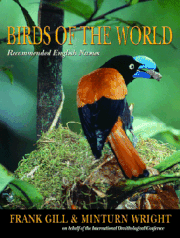Birds of the World: Recommended English Names
 |
|
| Author | Frank Gill and Minturn Wright |
|---|---|
| Country | United States |
| Language | English |
| Subject | Birds |
| Publisher | Christopher Helm / Princeton University Press |
|
Publication date
|
2006 |
| Media type | Print (paperback) |
| Pages | ix + 259 |
| ISBN | |
| OCLC | 69484497 |
Birds of the World: Recommended English Names is a paperback book, written by Frank Gill and Minturn Wright on behalf of the International Ornithologists' Union. The book is an attempt to produce a standardized set of English names for all bird species, and it is the product of a project set in motion at the 1990 International Ornithological Congress. It is supplemented by a website, the IOC World Bird List, giving updates to the published material.
An 11-page introduction deals with a number of issues which relate to the naming of birds. This is followed by a systematic list, from pages 12 to 211, and a 46-page index. The family sequence is that of the third edition of the Howard and Moore Complete Checklist of the Birds of the World. The book's cover is illustrated with a photo of a helmet vanga, a bird endemic to Madagascar.
Since the pioneering work of Linnaeus, species of organisms have had recognized scientific names in Latin, Greek, or a modernized derivative of one or both of those languages. In most groups of organisms, the scientific names are sufficient, enjoying widespread use among academics and amateurs alike. By contrast, non-scientific (vernacular) names for birds are extensively used in scientific communication as well as in the large community of amateur enthusiasts. However, vernacular names change frequently and often vary from place to place. Consequently, there is a need to have a degree of consistency in the vernacular names used around the world.
In the late 19th century, the American Ornithologists' Union (AOU) made an attempt to standardize the English names of birds; its effort covered the United States and Canada. This work's most recent edition, the seventh, covers North America as far south as Panama, but this omits some 80% of the world's species and is still sometimes controversial. A number of authors have come up with lists of birds of the world, but none had as its primary goal the standardization of names. As a result, the field of English names of birds was left "a swirling sea of polylexy and polysemy, where one bird may have many names and one name may apply to many birds."
...
Wikipedia
